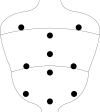The long term outcome of gastric non-invasive neoplasia
- PMID: 12865267
- PMCID: PMC1773761
- DOI: 10.1136/gut.52.8.1111
The long term outcome of gastric non-invasive neoplasia
Abstract
Background: The cancer risk associated with gastric non-invasive neoplasia (formerly dysplasia) is debated. This prospective long term follow up study investigates the clinicopathological behaviour of non-invasive gastric neoplasia (and related lesions), focusing on the cancer risk associated with each different histological phenotype.
Patients and methods: A total of 118 consecutive cases (nine indefinite for non- invasive neoplasia; 90 low grade non-invasive neoplasia; 16 high grade non- invasive neoplasia; and three suspicious for invasive adenocarcinoma) with a histological follow up of more than 12 months (average 52 months; range 12-206) were prospectively followed up with a standardised protocol. Patients in whom gastric cancer was detected within 12 months from the initial diagnosis of non-invasive neoplasia were excluded, assuming that invasive carcinoma had been missed at the initial endoscopy procedure.
Results: Non-invasive neoplasia was no longer detectable in 57/118 cases (48%), was unchanged in 32 (30%), and evolved into gastric cancer in 20 patients (17%). Evolution to invasive adenocarcinoma was documented in both low and high grade non-invasive neoplastic lesions (8/90 low grade; 11/16 high grade) and correlated with histological severity (low versus high grade) at baseline (p<0.001). Seventy five per cent of cancers occurring during the long term follow up were stage I.
Conclusions: The risk of invasive gastric cancer increases with the histological grade of the non-invasive neoplasia. Following up non-invasive gastric neoplasia increases the likelihood of gastric cancer being detected in its early stages.
Figures



References
-
- Correa P. A human model of gastric carcinogenesis. Cancer Res 1988;48:3554–60. - PubMed
-
- Correa P. Human gastric carcinogenesis: a multistep and multifactorial process. First American Cancer Society Award Lecture on Cancer Epidemiology and Prevention. Cancer Res 1992;52:6735–40. - PubMed
-
- Fenoglio-Preiser C, Carneiro F, Correa, et al. Gastric carcinoma. In: Hamilton SR, Aaltonen LA, eds. Pathology and Genetics, Tumors of the Digestive System. Lyon: IARC Press, 2000;39–52.
-
- Jass JR. A classification of gastric dysplasia. Histopathology 1983;7:181–93. - PubMed
Publication types
MeSH terms
LinkOut - more resources
Full Text Sources
Medical
